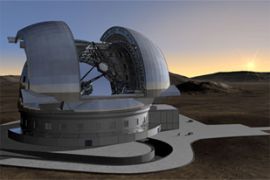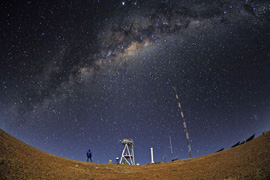Chile to host giant telescope
European-funded telescope promises to deliver unprecedented images of distant worlds.

 |
| Astronomers say the site in Chile’s Atacama desert offers clearest skies [ESO] |
With a power 15 times greater than the largest current optical telescope, that should enable the telescope to produce the first direct images of distant rocky planets similar to Earth orbiting in zones considered to be potentially habitable to life around other stars.
It will also be able to analyse the atmosphere of these so-called exo-planets to seek out the molecules that could indicate the presence of life.
Astronomers say the telescope should produce images far clearer and of objects even more distant than those seen from Nasa’s orbiting Hubble telescope.
With such a powerful reach, astronomers say the telescope could revolutionise our understanding of the universe and unravel some of its most mysterious secrets such as the origins of so-called dark matter and dark energy.
New discoveries
Beyond that, by simply looking far beyond where any man has ever looked before, ESO says the potential for new discoveries offered by the E-ELT is almost unlimited.
 |
| The new telescope will offer unparalleled reach deep into the universe [ESO] |
Tim de Zeeuw, ESO’s director-general, said the telescope promised to “vastly advance astronomical knowledge”.
The giant telescope will be housed in a rotating dome with a diameter of about 100 metres and rising to a height of about 80 metres.
Announcing the decision to build the telescope in Chile, ESO said the location in the arid Atacama desert provided the best conditions for peering out beyond the Earth’s atmosphere.
With low levels of water vapour in the air and an unusually high number of nights with clear skies, the site offers the least distortion in the telescopes line of sight.
Other locations in Chile had been considered, as well as a site in Spain’s Canary Islands.
As part of the project the Chilean government has agreed to designate a large tract of land near the site as a protected area, barring mining and other activities close to the telescope which could interfere with the clear skies.